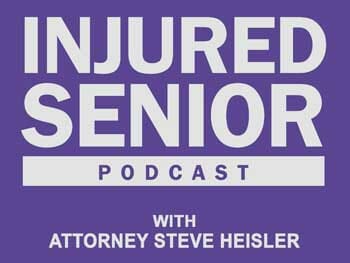
About Stan Andrzejewski: Stan is the founder of Greater Baltimore Yoga. He was certified in the Iyengar tradition in 1988 while a student of John Schumacher, but now considers Victor van Kooten as his main inspiration. He integrates 45 years of experience as a physical therapist into his 33 years of teaching yoga. He works with people with orthopedic and neurologic problems in his private practice. He has trained many yoga teachers through his apprenticeship program. He has taught a series of continuing education courses for physical therapists entitled Hatha Yoga as Physical Therapy.
In this episode, Steve and Stan discuss:
1. What is a neurological physical therapist?
- Working with and treating people with neurological issues. Working with children with cerebral palsy, muscular dystrophy, and adults with multiple sclerosis, and parkinsons.
2. How did you get involved in Yoga?
- I went to a Hatha Yoga conference in 1980 and then ended up taking a yoga class at college. I fell in love with yoga. When something just feels right, intuitively, it’s something that I know that I need to pursue.
3. Is it an accurate portrayal of yoga to say that yoga is only for people who are double jointed, who have been gymnasts, or people who can put their legs behind their neck?
- Not at all yoga is really for everyone. It can be used to help with basic balance issues and relief of pain. The way we move we can hurt ourselves and perpetuate certain kinds of issues, pains, by the way we stand, sit, and move. Most people don’t even realize that they’re actually causing themselves physical pain, by the way they move or don’t move.
4. Why should seniors and our elderly community be interested in doing and performing yoga?
- Well, basically to stay independent and to stay out of pain. We perpetuate our pain and can get very sensitive to certain kinds of mechanical stress just by standing.
5. What is mechanical stress?
- Gravity weight bearing pressure stress on the joints.
6. Does yoga and movement therapy train one’s nervous system, condition the cardiovascular system, and protect the body from the accumulated mechanical and stresses of aging?
- It does! Training is retraining our nervous system through repetition.
7. I have a history of bad posture, are you saying that I learned that from a young age?
- Yes, it’s learned, and it can be unlearned, we have to pay attention to what we’re doing that’s creating pain. Pain is a great reminder that we’re doing something wrong. Through the skills of grounding, centering and lifting we’re paying attention to the sensations of the body, and then we can create the intentional movement.
8. So, are you saying that when the elderly and senior population get to their 60s or 70s, that there’s going to be problems because they have developed these habits and these postures and weight bearing issues over years and years and years?
- Yes, most people do. It’s the idea of being able to start at any time to head in the right direction. We’re either heading in the wrong direction, or we’re heading in the right direction. We can lament we didn’t start earlier that we created this thing called arthritis, but we can actually work on our independence and our confidence in moving and have ways to relieve the pains that may happen.
9. Can yoga or movement therapy also help people who have experienced injuries that cause them to have all different types of aches, pains, fractures, surgeries, and the like?
- Whenever someone is injured it’s a sudden, very acute assault on their physical body and every other aspect of them as well. There’s recovery, there is the ability for our bones to mend and our bruises to resolve but our movements become compensatory, because we’re learning a way to avoid something when it’s an acute situation. Then we have to unlearn that. So we’re always trying to move in the right direction, but the art is to do it gently, gradually, and precisely enough that we don’t reinjure ourselves, or cause other kinds of issues. Most yoga classes are way too aggressive for seniors, and we need to slow it down, be very gradual and very attentive to exactly what they’re doing in each moment.
10. What are some exercises or movements that someone waking up with arthritis, or all stiff, achy, and unable to move well, can do that can help them to not experience the stiffness and the pain?
- Lying on their back, bring their knees to chest, and just gently exhale as they pull with their hands, their legs, their shins into them to press their low back into the mattress. Then sit up on the side of the bed, and I lean over with your legs spread wide with your feet well established on the floor, and you simply bend over. Slowly and gradually is the key. Lean in and try to bring their hands closer to the floor and drop their head. Slowly, what they have to do is calm their head last and their belly first. They put the weight in their legs, their feet and lift their toes. It wakes up their feet to start to be able to feel the floor, and then they stand up belly first, and still keep their chin tucked. They may have to walk their hands up their legs or press into a nightstand or something, because that helps the belly. Finally, after they’re still lifting their toes, work in their legs and take their belly back. I ask them to lift their heart, their chest And the last moment if that’s all working really well enough finally their head, so they slowly stand up.
11. If people have a weight bearing problem, wouldn’t standing up cause a problem?
- With people with low back joint problems bending forward, knees to chest is relieving. When they extend or stand up straight and when their bones and their joints are straight and standing up tall, they’re in what I call a provocative position, meaning that you can either provoke yourself into joint pressure and pain.
12. So yoga, movement therapy, is going to help seniors and elderly individuals be able to get out of bed without falling and be able to get out of bed without having a lot of aches and pains, if they do some of the exercises that you were talking about, correct?
- Yes.
13. What’s another exercise that people could utilize or they could do that could help them with the low back pain?
- Well, there are variations of knees to chest. Flexion is a relieving position. So from knees to chest, some people can from all fours rock back, we call it Child’s Pose where they set down their butt back towards their feet, if your knees allow. Another great pose is to lay down on your back and prop your legs way up. If you can get down on the floor, you would prop your calves up on a coffee table, a seat of a chair, or up the wall. If you can’t get on the floor, you would put something higher, like a chair on your couch or something to raise your legs up to bend your hips.
14. What about senior or elderly individuals who have rotator cuff, shoulder injuries, they have problems lifting their arm, or just mobility with their extremity? What would you recommend for those individuals?
- Shoulders and necks are some of the more difficult things to work on with anybody. If you think of movement like to look up or raise your arm over your head, it’s the end of a chain of events that started with your feet on the floor standing or your sit bones on a chair sitting, and then you move. To be able to move your head, neck, your arm, or your shoulder you need a great foundation, the foundation of your spine, the foundation of your pelvis. If you’re sitting, the foundation of your legs pressing into the floor. If that all were to collapse, there’s no foundation for you then to move your arm and that’s where rotator cuff problems come into play.
15. What’s an exercise that people with knee or hip replacements can do?
- Activate your legs by lifting your toes. Pressing your heels, the four corners of the feet into the floor, lifting your toes will support your knee and your hip instead of collapsing into it, and putting all the torques and rotations, twists and stresses on those joints.
16. What’s an exercise or something that our audience can do that can make them healthier and a little more flexible?
- Pay attention to your breathing. Breathe through your nose, in breath and out breath through the nose and feel the gentle movements and sensations that you make in your belly, ribs, or in your nostrils. Pay attention to your breath. It is critical for you to be able to pay attention to the body’s sensations. Pay attention to your body, not just the emotions and thoughts that you have, but to the sensations of your body.
“Pay attention to your body, not just the emotions and thoughts that you have, but to the sensations of your body.” — Stan Andrzejewski
To find out more about the National Injured Senior Law Center or to set up a free consultation go to https://www.injuredseniorhotline.com/ or call 855-622-6530
Connect with Stan Andrzejewski:
Website: Maryland Yoga.com
Email: Stan@marylandyoga.com
CONNECT WITH STEVE H. HEISLER:
Website: http://www.injuredseniorhotline.com
Facebook: https://www.facebook.com/attorneysteveheisler/
LinkedIn: https://www.linkedin.com/company/the-law-offices-of-steven-h.-heisler/about/
Email: info@injuredseniorhotline.com
Show notes by Podcastologist: Kristen Braun
Audio production by Turnkey Podcast Productions. You’re the expert. Your podcast will prove it.
